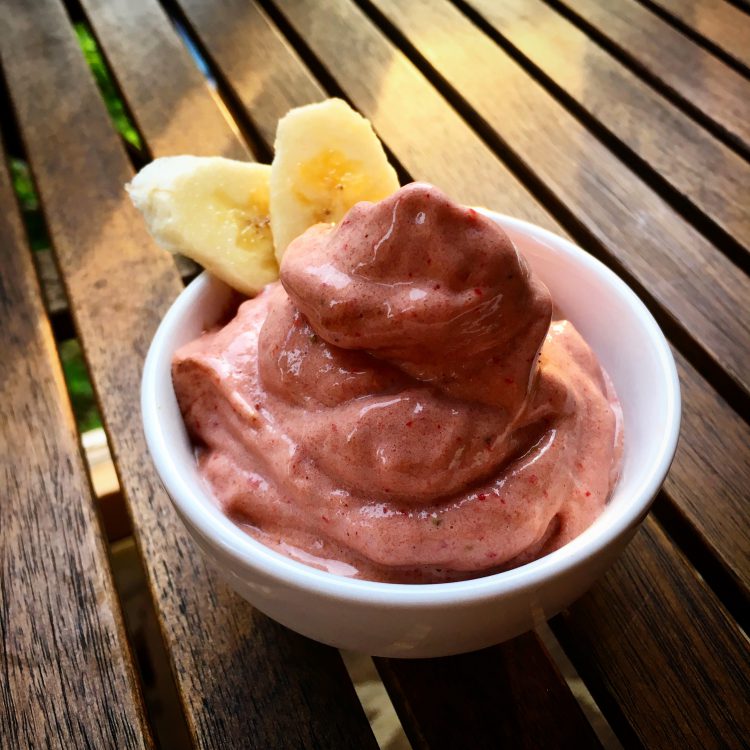Banana Split Ice Cream – Wait Until You Try This Twist

Although you may fool some, this delicious icy treat has no cream or ice. This dairy-free alternative to ice cream is a great option for our lactose-intolerant friends and a healthier option for us all! Even better, this sweet-treat has no added sugar and contributes to our daily recommended intake of fruit. According to the USDA’s MyPlate, most adults should consume 1 ½ to 2 cups of fruit each day.
Makes 4, ½ cup servings
Ingredients
- 2 medium bananas, sliced and frozen
- 1 cup strawberries, sliced and frozen
- 2 tbsp unsweetened cocoa powder
Equipment
- Food Processor (A powerful blender can be used but may require a longer blending time.)
Instructions
- Peel and slice the bananas. Wash, de-stem and slice the strawberries. Freeze the fruit ahead of time (at least 3 hours.)
- Place frozen fruit slices into a food processor.
- Cover and process until the fruit reaches a creamy consistency, about 3-5 minutes. You may have to scrape the sides of the food processor periodically, patience is key here!
- Add the cocoa powder and continue to process until the desired consistency has been reached.
- Scrape the mixture into a bowl, enjoy immediately or store in the freezer.
Try mixing it up with different fruits and flavors to find your family’s favorite combination. My personal favorite is bananas, peanut butter powder, and cinnamon!
Megan
Megan is the Adult EFNEP Nutrition Educator at NC Extension, Orange County.
Tips for School Lunch As The Year Begins

It’s been quite some time since I’ve eaten in my old school cafeteria. I have fond memories of school lunch. It was usually around mid-morning (while changing classes) that I remember smelling the scent of lunch coming through the air. My classmates and I were always trying to figure out the menu of the day. We were also very eager to hear the bell ring after the last morning class because we knew that it was “lunch time.” Some of my favorite cafeteria items were the following: Beef-a-Roni with corn and a yeast roll; vegetable beef soup with a peanut butter and jelly sandwich; pizza; hot dogs/cheeseburgers and tater tots; and everyone’s favorite. . . .fried chicken. Each meal also included a dessert and milk. Not only did I enjoy the food, but I also enjoyed seeing my friends.
Options for school lunches have really advanced since my days of eating them. Kids have a lot of control over what they eat for lunch at school. A child can choose to eat the green beans or throw them out. A kid also can decide to eat an apple instead of an ice cream sandwich.
When choosing what to eat for lunch, making a healthy choice is really important. Here’s why: Eating a variety of healthy foods gives you the energy to do stuff, helps you grow the way you should, and can even keep you
Think of school lunch as the fuel you put in your tank. If you choose the wrong kind of fuel, you might run out of energy before the day is over.
So, what is the right kind of fuel? What does a healthy lunch look like? There are many answers to these questions.
Most kids have the choice of packing lunch or buying one at school. The good news is that a kid can get a healthy meal by doing either one. But it’s not a slam-dunk. Chances are, some meals and foods served in the school cafeteria are healthier than others.
That doesn’t mean you shouldn’t buy your lunch; it just means you might want to give the cafeteria menu a closer look. Read the cafeteria menu the night before. Knowing what’s for lunch beforehand will let you know if you want to eat it! Bring home a copy of the menu or figure out how to find it on the school website.
A packed lunch isn’t automatically healthier than one you buy at school. If you pack chocolate cake and potato chips, that’s not a nutritious meal! But a packed lunch, if you do it right, does have a clear advantage. When you pack your lunch, you can be sure it includes your favorite healthy foods — stuff you know you like. It’s not a one-size-fits-all meal. It’s a lunch just for you. If your favorite sandwich is peanut butter and banana, just make it and pack it — then you can eat it for lunch. Or maybe you love olives. Go ahead and pack them!
If you want to pack your lunch, you’ll need some help from your parents. Talk to them about what you like to eat for your lunch so they can stock up on those foods. It’s a way to show that you’re growing up.
Steps to a Great Lunch
Whether you pack or buy your lunch, follow these guidelines:
- Choose fruits and vegetables. Fruits and vegetables are like hitting the jackpot when it comes to nutrition. They make your plate more colorful, and they’re packed with vitamins and fiber. It’s a good idea to eat at least five servings of fruits and vegetables every day, so try to fit in one or two at lunch. A serving isn’t a lot. A serving of carrots is a ½ cup or about 6 baby carrots. A fruit serving could be one medium orange.
Know the facts about fat. Kids need some fat in their diets to stay healthy — it also helps keep you feeling full — but you don’t want to overeat fats. Fat is found in butter, oils, cheese, nuts, and meats. Some higher-fat lunch foods include french fries, hot dogs, cheeseburgers, macaroni and cheese, and chicken nuggets. Don’t worry if you like these foods! No food is bad, but you may want to eat them less often and in smaller portions. Foods that are lower in fat are usually baked or grilled. Some of the best low-fat foods are fruits, vegetables, and skim and low-fat milk. - Let whole grains reign. “Grains” include bread, cereals, rice, and pasta. But as we learn more about good nutrition, it’s clear that whole grains are better than refined grains. What’s the difference? Brown rice is a whole grain, but white rice is not. Likewise, whole-wheat bread contains whole grains, whereas regular white bread does not.
Slurp sensibly. It’s not just about what you eat — drinks count, too! Milk has been a favorite lunchtime drink for a long time. If you don’t like milk, choose water. Avoid juice drinks and sodas. - Balance your lunch. When people talk about balanced meals, they mean meals that include a mix of food groups: some grains, some fruits, some vegetables, some meat or protein foods, and some dairy foods such as milk and cheese. Try to do this with your lunch. If you don’t have a variety of foods on your plate, it’s probably not balanced. A double order of french fries, for example, would not make for a balanced lunch.
- Steer clear of packaged snacks. Many schools make salty snacks, candy, and soda available in the cafeteria or vending machines. It’s OK to have these foods once in a while, but they shouldn’t be on your lunch menu.
- Mix it up. Do you eat the same lunch every day? If that lunch is a hot dog, it’s time to change your routine. Keep your taste buds from getting bored and try something new. Eating lots of different kinds of food gives your body a variety of nutrients.
- Quit the clean plate club. Because lunch can be a busy time, you might not stop to think whether you’re getting full. Try to listen to what your body is telling you. If you feel full, it’s OK to stop eating.
- Cafeterias sometimes look like feeding time at the zoo. Don’t be an animal! Follow those simple rules your parents are always reminding you about: Chew with your mouth closed. Don’t talk and eat at the same time. Use your utensils. Put your napkin on your lap. Be polite. And don’t make fun of what someone else is eating.
- Don’t drink milk and laugh at the same time! Whatever you do at lunch, don’t tell your friends a funny joke when they’re drinking milk. Before you know it, they’ll be laughing, and that milk will be coming out their noses! Gross!
Enjoy!
Stephanie
Stephanie is an Extension Associate for NC EFNEP
Source: http://kidshealth.org/en/kids/school-lunches.html
Bowling

Did you know that National Bowling Day is every year on the second Saturday in August? This year, National Bowling Day falls on August 12, which is tomorrow! Bowling is a unique sport that you can comfortably play on hot summer days or chilly winter days since you play inside at a bowling alley. It provides a great environment to learn sportsmanship and etiquette. Bowling is also a fun way for children and adolescents to connect with their friends (and family!) after school and on the weekend.
The goal of bowling is to knock down the 10 pins at the end of the lane with your bowling ball in one turn (you get two tries per turn). One bowling round consists of one turn per player, and each game has 10 rounds. If you knock all your pins down in one try, it’s called a “strike” and the next player takes their turn. If you don’t knock all of your pins down in one try, you get a second try to do so. Knocking all of your pins down in two tries gives you a “spare.” Most bowling alleys have automatic electronic scorekeepers. Watch these videos to learn proper form and how to release the bowling ball.
It’s especially important for children to use the proper size bowling ball. Bowling balls come in different weights, with 6 pounds being the smallest. Preschoolers who can hold a 6 pound ball may be able to play if they can throw the ball safely down the lane. Allow them to throw the ball however they’re comfortable, which may be rolling it in between their legs. The alley can also raise the bumpers on the lane to make it easier for new or younger players by preventing the ball from going down the gutter. School-aged children and teens can learn the general rules and more advanced techniques when they’re ready.
Not only is bowling fun, but it can be great exercise! You can burn around 100 calories per hour while bowling. Bowling uses 134 muscles and can help build strong bones and muscles. It also improves hand-eye coordination and balance and can help relieve stress!
For younger children, you can make your own “bowling” game they can play at home! Try using a toy ball as the bowling ball and empty water bottles as the pins. Arrange the bottles and let your child try and knock them down with a ball. This can help prepare younger children by familiarizing them with the technique before they get old enough to bowl at an alley. Check out this tutorial to make your own colorful “pins”–your kids can even help you!
For more information on bowling and youth bowling, visit https://www.bowl.com. To find bowling alleys near you, visit https://gobowling.com/Find-A-Center. You may even find some free games of bowling!
Share how your children enjoy their bowling experience!
Learn benefits of eating together

Family meals help provide regular, consistent opportunities to create shared experiences that are meaningful and offer a sense of belonging to all. Research has shown that regular and meaningful family meals offer a large variety of benefits to children and parents.
Family meals provide a sense of family unity and identity. Family meals become a vehicle for carrying on valued family traditions, such as having a particularly favorite dish on someone’s birthday or going to a favorite place to eat together on special occasions.
Family meals make a positive impact on young children’s language acquisition and literacy development. Family meals furnish a daily opportunity for a parent or sibling to speak to an infant or toddler, and help them learn words, understand language and build a conversation.
Family meals are associated with improved dietary intake among family members. For example, several large studies have shown that regular family meals are strongly associated with increased consumption of fruits, vegetables, grains and other healthy food choices while also linked with lesser consumption of fried or fatty foods, soft drinks or other less healthy food choices.
Click the link under Source to learn more about strengthening family bonds and improving your family’s wellness here:: https://www.ag.ndsu.edu/eatsmart/eat-smart.-play-hard.-magazines-1/2009-eat-smart-play-hard-magazine/test-item
Enjoy!
Neha
Neha is a Special Projects Assistant for NC EFNEP.
Slow Cooker Meals for Busy Week Nights

Usually, people start using their trendy slow cooker in the fall. But in my house, I like to use this magic appliance all year around. The slow cooker does all the work of cooking for me while I am busy at work or with my kids and minimize my time spent in the kitchen. I like how they are perfect for stews, soups, and easy chicken dinners. They are also super easy to clean.
Here are some other benefits and safety tips of a slow-cooker for you.
Benefits:
- Helps you to eat more meals at home and eliminates the temptation to order take-out which is often less nutritious and more expensive.
- It usually allows one-step preparation, saving extra prep and clean up time.
- As a result of the long, low-temperature cooking, slow cookers help tenderize less-expensive cuts of meat.
- A slow cooker uses less electricity than an oven.
Safety tip:
- Rub the inside of the stoneware with oil or spray it with non-stick cooking spray before using it for an easy cleanup.
- Do not put frozen meat and poultry in your slow cooker. Always thaw the meat and poultry in the refrigerator before hand to ensure proper cooking.
- Don’t fill the slow cooker to less or too full. Cooking too little or too much food in the slow cooker can affect cooking time, quality and the safety.
- Always keep the lid in place during cooking. Removing the lid slows cooking time.
Enjoy and don’t forget to share your favorite slow-cooker recipe.
Neha
Neha is a Special Projects Assistant for NC EFNEP
SOURCE: http://www.eatright.org/resource/food/planning-and-prep/snack-and-meal-ideas/slow-cooker-tips-for-busy-weeknights